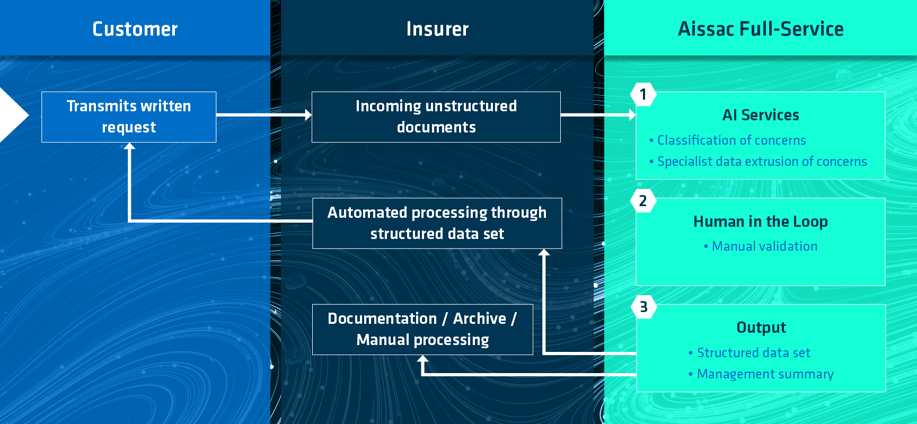Imagine that a policyholder goes to the doctor, takes a picture of their bill, and submits the bill without any further details such as their insurance policy number or the type of document (e.g., the type of invoice). The policyholder receives a real-time notification that the invoice has been refunded, and at the same time, a notification from their bank or payment service provider that the amount of the refund has been credited to their account. They also receive a short real-time notification if their appointment or treatment is not covered. Perhaps they are also offered additional, customized coverage directly.
The dawn of a new era? Customers and private health insurers would like to think so. In today's world, however, it is often difficult for policyholders to submit medical records digitally, as apps must be in place and large amounts of insurance-related information must be included in the submission process. This data is often not known, and in some cases, can only be provided if the policyholder possesses specific insurance-related expertise.
Claims processing presents recurring challenges not only for patients, but also for private health insurance providers. Since policyholders usually submit their bills in bundles only once or twice per year, these seasonal fluctuations can lead to peak loads during claims processing. Moreover, when policyholders take pictures of bills, they don't always pay attention to kinks in documents, lighting conditions, or whether the background provides for sufficient contrast. Poor quality can make it difficult to decipher the required information.
In the field of private health insurance, automated processes and quick decisions — and in particular, the quality of the data obtained from documents during input management — are of the utmost importance. After all, processes can only be fully automated if data is correct.
A realistic look at AI in input management
Private health insurance providers are already using artificial intelligence or rule-based systems to automatically classify documents and extract relevant data. However, despite this artificial intelligence, existing input management solutions are often unable to correctly identify and extract essential data. As a result, employees of the respective private health insurance provider must manually reenter or validate the machine-generated data, making end-to-end automation impossible.
The reality of AI in input management:
"Despite the latest machine learning technologies, data must still be processed by humans."
Seasonal fluctuations, which can lead to extremely large numbers of claims being received at once, make it even more difficult to rectify poor data recognition as staff and other manual resources cannot always be sufficiently planned in advance.
Insurance providers must usually implement several extensive projects in order to introduce a completely new AI-based input management system or upgrade an existing input management solution with AI. Achieving short-term added value is therefore difficult due to the lengths of the projects involved and the need to train employees on the new processes and interfaces.
In order for input management to be successful, artificial and human intelligence must go hand in hand
Above all, the success of input management is measured by the quality of data. In order for business processes to be fully automated, the accuracy of data captured by input management must be close to 100%. Only then does it make sense to automate business processes in the first place. However, 100% data quality can currently only be achieved via an effective combination of artificial and human intelligence.
To relieve the burden on private health insurance providers, and above all, to achieve short-term added value, input management can be implemented as a
"Structured data as a service"
with Aisaac Full-Service Support. Private health insurance providers simply transmit the documents they receive from their policyholders, then obtain structured, machine-readable data that can be processed automatically, as well as a human-readable management summary for traceability.

Fig. 1: Aisaac Full-Service Support
Aisaac Full-Service Support ensures a data quality of nearly 100% by combining AI and HITL ("human-in-the-loop" or human intelligence). Aisaac is easy to use as there is no need to implement or integrate one's own software, and helps compensate for peak loads and seasonal fluctuations via the use of a service.
Conclusion
Despite the use of artificial intelligence in input management, manual operations such as reentry and validation are often still necessary. These manual resources subsequently interrupt the automated processing of the data. To relieve insurers in the short term, input management can be offered as a service that ensures excellent data recognition via the combination of human and artificial intelligence, thus forming the basis for end-to-end automation.
Would you like to find out more about the use of AI in input management and our Aisaac solution for straight-through-processing without media discontinuity? Then please contact our expert Florian Petermann, Senior Business Developer at adesso insurance solutions.


Do you have any questions or comments? Then please leave us a comment.